Ejection seat
This article needs additional citations for verification. (May 2013) |
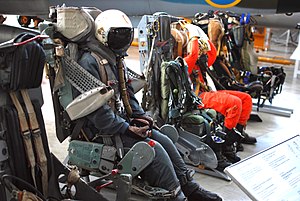
In
History
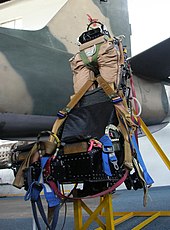
A bungee-assisted escape from an aircraft took place in 1910. In 1916, Everard Calthrop, an early inventor of parachutes, patented an ejector seat using compressed air.[1]
The modern layout for an ejection seat was first introduced by Romanian inventor
The design was perfected during
The first ejection seats were developed independently during World War II by
In Sweden, a version using compressed air was tested in 1941. A gunpowder ejection seat was developed by
As the first operational military jet in late 1944 to ever feature one, the winner of the German Volksjäger "people's fighter" home defense jet fighter design competition; the lightweight
After World War II, the need for such systems became pressing, as aircraft speeds were getting ever higher, and it was not long before the sound barrier was broken. Manual escape at such speeds would be impossible. The United States Army Air Forces experimented with downward-ejecting systems operated by a spring, but it was the work of James Martin and his company Martin-Baker that proved crucial.
The first live flight test of the Martin-Baker system took place on 24 July 1946, when fitter Bernard Lynch ejected from a Gloster Meteor Mk III jet. Shortly afterward, on 17 August 1946, 1st Sgt. Larry Lambert was the first live U.S. ejectee. Lynch demonstrated the ejection seat at the Daily Express Air Pageant in 1948, ejecting from a Meteor.[5] Martin-Baker ejector seats were fitted to prototype and production aircraft from the late 1940s, and the first emergency use of such a seat occurred in 1949 during testing of the jet-powered Armstrong Whitworth A.W.52 experimental flying wing.
Early seats used a solid propellant charge to eject the pilot and seat by igniting the charge inside a telescoping tube attached to the seat. As aircraft speeds increased still further, this method proved inadequate to get the pilot sufficiently clear of the airframe. Increasing the amount of propellant risked damaging the occupant's spine, so experiments with
In the early 1960s, deployment of rocket-powered ejection seats designed for use at supersonic speeds began in such planes as the
at an altitude of 80,000 ft (24,000 m). The pilot was recovered successfully, but the launch control officer drowned after a water landing. Despite these records, most ejections occur at fairly low speeds and altitudes, when the pilot can see that there is no hope of regaining aircraft control before impact with the ground.Late in the Vietnam War, the U.S. Air Force and
Pilot safety
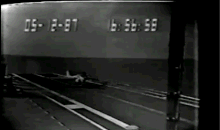
The purpose of an ejection seat is pilot survival. The pilot typically experiences an acceleration of about 12–14
It was theorised early on that ejection at supersonic speeds would be unsurvivable; extensive tests, including
The capabilities of the NPP Zvezda K-36 were unintentionally demonstrated at the Fairford Air Show on 24 July 1993 when the pilots of two MiG-29 fighters ejected after a mid-air collision.[11]
The minimal ejection altitude for ACES II seat in inverted flight is about 140 feet (43 m) above ground level at 150 KIAS, while the Russian counterpart – K-36DM has the minimal ejection altitude from inverted flight of 100 feet (30 m) AGL. When an aircraft is equipped with the NPP Zvezda K-36DM ejection seat and the pilot is wearing the КО-15 protective gear, they are able to eject at airspeeds from 0 to 1,400 kilometres per hour (870 mph) and altitudes of 0 to 25 km (16 mi or about 82,000 ft). The K-36DM ejection seat features drag chutes and a small shield that rises between the pilot's legs to deflect air around the pilot.[12]
Pilots have successfully ejected from underwater in a handful of instances, after being forced to ditch in water. The first recorded case was Lt. B. D. Macfarlane of the Royal Navy Fleet Air Arm when he successfully ejected under water using his Martin-Baker Mk.1 ejection seat after his Westland Wyvern had ditched on launch and been cut in two by the carrier on 13 October 1954.[13] Documented evidence also exists that pilots of the US[14] and Indian navies have also performed this feat.[15][16]
As of 20 June 2011[update] – when two Spanish Air Force pilots ejected over San Javier airport – the number of lives saved by Martin-Baker products was 7,402 from 93 air forces.[17] The company runs a club called the "Ejection Tie Club" and gives survivors a unique tie and lapel pin.[18] The total figure for all types of ejection seats is unknown, but may be considerably higher.
Early models of the ejection seat were equipped with only an overhead ejection handle which doubled in function by forcing the pilot to assume the right posture and by having them pull a screen down to protect both their face and oxygen mask from the subsequent air blast. Martin Baker added a secondary handle in the front of the seat to allow ejection even when pilots weren't able to reach upwards because of high g-force. Later (e.g. in Martin Baker's MK9) the top handle was discarded because the lower handle had proven easier to operate and the technology of helmets had advanced to also protect from the air blast.[19]
Egress systems
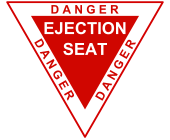
The "standard" ejection system operates in two stages. First, the entire canopy or hatch above the aviator is opened, shattered, or jettisoned, and the seat and occupant are launched through the opening. In most earlier aircraft this required two separate actions by the aviator, while later egress system designs, such as the Advanced Concept Ejection Seat model 2 (ACES II), perform both functions as a single action.
The ACES II ejection seat is used in most American-built fighters. The A-10 uses connected firing handles that activate both the canopy jettison systems, followed by the seat ejection. The F-15 has the same connected system as the A-10 seat. Both handles accomplish the same task, so pulling either one suffices. The F-16 has only one handle located between the pilot's knees, since the cockpit is too narrow for side-mounted handles.
Non-standard egress systems include Downward Track (used for some crew positions in bomber aircraft, including the
Early models of the
Similarly, two of the six ejection seats on the B-52 Stratofortress fire downward, through hatch openings on the bottom of the aircraft; the downward hatches are released from the aircraft by a thruster that unlocks the hatch, while gravity and wind remove the hatch and arm the seat. The four seats on the forward upper deck (two of them, EWO and Gunner, facing the rear of the airplane) fire upwards as usual. Any such downward-firing system is of no use on or near the ground if aircraft is in level flight at the time of the ejection.
Aircraft designed for low-level use sometimes have ejection seats which fire through the canopy, as waiting for the canopy to be ejected is too slow. Many aircraft types (e.g., the
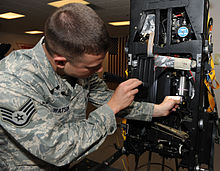
Through-Canopy Penetration is similar to Canopy Destruct, but a sharp spike on the top of the seat, known as the "shell tooth", strikes the underside of the canopy and shatters it. The A-10 Thunderbolt II is equipped with canopy breakers on either side of its headrest in the event that the canopy fails to jettison. The T-6 is also equipped with such breakers if the MDC fails to detonate. In ground emergencies, a ground crewman or pilot can use a breaker knife attached to the inside of the canopy to shatter the transparency. The A-6 Intruder and EA-6B Prowler seats were capable of ejecting through the canopy, with canopy jettison a separate option if there is enough time.
CD and TCP systems cannot be used with canopies made of flexible materials, such as the
Soviet VTOL naval fighter planes such as the Yakovlev Yak-38 were equipped with ejection seats which were automatically activated during at least some part of the flight envelope.[citation needed]
Drag Extraction is the lightest and simplest egress system available, and has been used on many experimental aircraft. Halfway between simply "bailing out" and using explosive-eject systems, Drag Extraction uses the airflow past the aircraft (or spacecraft) to move the aviator out of the cockpit and away from the stricken craft on a guide rail. Some operate like a standard ejector seat, by jettisoning the canopy, then deploying a drag chute into the airflow. That chute pulls the occupant out of the aircraft, either with the seat or following release of the seat straps, who then rides off the end of a rail extending far enough out to help clear the structure. In the case of the Space Shuttle, the astronauts would have ridden a long, curved rail, blown by the wind against their bodies, then deployed their chutes after free-falling to a safe altitude.
Encapsulated Seat egress systems were developed for use in the
Some aircraft designs, such as the
Zero-zero ejection seat
A zero-zero ejection seat is designed to safely extract upward and land its occupant from a grounded stationary position (i.e., zero altitude and zero airspeed), specifically from aircraft cockpits. The zero-zero capability was developed to help aircrews escape upward from unrecoverable emergencies during low-altitude and/or low-speed flight, as well as ground mishaps. Parachutes require a minimum altitude for opening, to give time for deceleration to a safe landing speed. Thus, prior to the introduction of zero-zero capability, ejections could only be performed above minimum altitudes and airspeeds. If the seat was to work from zero (aircraft) altitude, the seat would have to lift itself to a sufficient altitude.
These early seats were fired from the aircraft with a cannon, providing the high impulse needed over the very short length on the cannon barrel within the seat. This limited the total energy, and thus the additional height possible, as otherwise the high forces needed would crush the pilot.
Modern zero-zero technology use small rockets to propel the seat upward to an adequate altitude and a small explosive charge to open the parachute canopy quickly for a successful parachute descent, so that proper deployment of the parachute no longer relies on airspeed and altitude. The seat cannon clears the seat from the aircraft, then the under-seat rocket pack fires to lift the seat to altitude. As the rockets fire for longer than the cannon, they do not require the same high forces. Zero-zero rocket seats also reduced forces on the pilot during any ejection, reducing injuries and spinal compression.
Other vehicles
The
The only commercial jetliner ever fitted with ejection seats was the Soviet
The Lunar Landing Research Vehicle, (LLRV) and its successor Lunar Landing Training Vehicle (LLTV), used ejection seats. Neil Armstrong ejected on 6 May 1968, following Joe Algranti and Stuart M. Present.[20]
The only spacecraft ever flown with installed ejection seats were
Early flights of the Space Shuttle, which used Columbia, were with a crew of two, both provided with ejector seats (STS-1 to STS-4), but the seats were disabled and then removed as the crew size was increased.[22] Columbia and Enterprise were the only two Space Shuttle orbiters fitted with ejection seats. The Buran-class orbiters were planned to be fitted with K-36RB (K-36M-11F35) seats, but as the program was canceled, the seats were never used.
No real life land vehicle has ever been fitted with an ejection seat, though it is a common trope in fiction. A notable example is the
See also
- Attacks on parachutists - discusses the 1949 Geneva Conventions on War, declaring it illegal to attack ejecting aircrew until they land
- Caterpillar Club
- Dynamic response index
- Escape pod
- Launch escape system
- Airborne lifeboat
- Lifeboat
- Pressure suit
- Ejection Tie Club
Notes
Explanatory notes
Citations
- ^ "1910s". Ejection-history.org.uk. Archived from the original on 2010-11-22. Retrieved 2012-10-30.
- ISBN 0-88365-666-3.
- ^ "Moved". Canit.se. Archived from the original on 2012-07-16. Retrieved 2012-10-30.
- ^ "Moved". Canit.se. Archived from the original on 2011-09-27. Retrieved 2012-10-30.
- ^ "flight july | expressat gatwick | a/r d/wl | 1948 | 1092 |". Flight. Flightglobal.com. 1948-07-15. Archived from the original on 2012-11-06. Retrieved 2012-10-30.
- ISBN 1-880588-23-4, page 90
- ^ Hearst Magazines (September 1969). "A Hot Seat". Popular Mechanics. Hearst Magazines. p. 90.
- ^ "1972 | 0502 | Flight Archive". Flightglobal.com. 1972-03-02. Archived from the original on 2012-11-02. Retrieved 2012-10-30.
- Naval Historical Center. 16 April 2001. Archivedfrom the original on 2016-10-31. Retrieved 2016-10-31.
- ASIN B0019QSQ1E. Archivedfrom the original on 2015-05-01. Retrieved 2014-05-17.
- ^ "The Mig-29 crash at Fairford Airbase". Sirviper.com. 2006. Archived from the original on 2018-02-06. Retrieved 2018-11-18.[self-published source]
- ^ "Ejection seat К-36D-3,5". NPP Zvezda. Archived from the original on 2016-10-31. Retrieved 2016-10-31.
- ^ ejection-history.org.uk Aircraft by Type: Westland Wyvern
- ^ "Underwater Ejection". The Ejection Site. April 15, 1997. Archived from the original on 2012-04-07. Retrieved 2012-04-20.[self-published source]
- ^ Vinod Pasricha (June 1986). "Aircraft Underwater". Bharat Rakshak. Archived from the original on 2014-09-23.
- ^ "Navy's first underwater ejection". The New Indian Express. 4 September 2009. Archived from the original on 2016-10-31. Retrieved 2016-10-31.
- ^ "PARIS: Martin-Baker seats save in Spain". Flight Global. June 21, 2011. Archived from the original on 2016-10-31. Retrieved 2016-10-31.
- ^ "Ejection Tie Club". Martin-Baker. Archived from the original on 2016-11-02. Retrieved 2016-10-31.
- ^ "The history and developments of Martin-Baker escape systems" (PDF). Martin-Baker. pp. 4, 17, 19, 36–37. Archived from the original (PDF) on 2013-09-03.
- ^ "Watch Neil Armstrong Narrowly". 27 August 2012. Archived from the original on 2012-12-28. Retrieved 2013-05-15.
- ^ "The Ejection Site". Archived from the original on 2013-04-03. Retrieved 2013-05-15.
- ISBN 0-9633974-4-3
General and cited references
- Terry, Gerard (August–November 1984). "Talkback". ISSN 0143-5450.
External links
| External image | |
|---|---|
| Martin Baker Mk 1 ejection seat drawing | |
Flight Global |
- "Up, Out and Down". Flight International. 14 November 1952.
- "Safety for Service Aircrew". Flight International. 16 December 1965.
- Kevin Coyne (1996–2003). "The Ejection Site".[self-published source]
- Kalikiano Kalei (February 27, 2008). "A History of Military Aircraft Egress Systems (Part One of Three)". Authorsden.com.[self-published source]
- "IN PICTURES: Lethbridge CF-18 jet fighter crash". The Globe and Mail. July 23, 2010.
- Michael Bennett (1980–2014). "Ejection History".[self-published source]
- "Mk10 seat". Martin-Baker. Archived from the original on 2007-10-07.
- "In Pictures: A Potted History Of Ejection Seats". Aviation Week. Oct 28, 2016.
- Bull, John O.; Serocki, Edward L.; McDowell, Howard L. (September 1966). "Compilation of Data on Crew Emergency Escape Systems" (PDF). Air Force Flight Dynamics Laboratory. Retrieved 1 April 2023.[permanent dead link]
